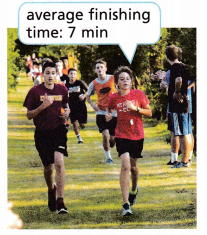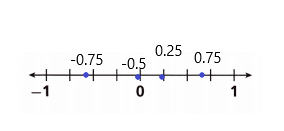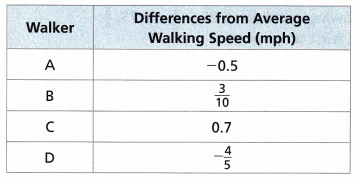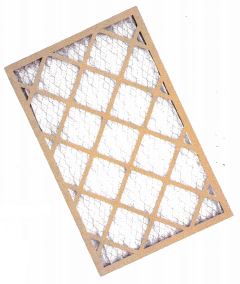We included HMH Into Math Grade 6 Answer Key PDF Module 2 Lesson 4 Order Rational Numbers to make students experts in learning maths.
HMH Into Math Grade 6 Module 2 Lesson 4 Answer Key Order Rational Numbers
I Can order positive and negative rational numbers of different forms.

1. The average weight of an adult African pygmy mouse is 0.27 ounce. Weights of the mice vary depending on age, diet, and whether the mouse is male or female. The differences from average weight in ounces for a set of African pygmy mice at a zoo are shown.
0.09, -0.14, 0.12, 0.06, -0.1
A. How can you use a number line to order the numbers?
________________________
________________________
________________________
Answer:
we can point out each and every number to graph in the number line.
B. Graph the numbers on the number line.

Answer:

C. Complete the statements using the graph in Part B.
A number to the left of a second number on a number line is
![]() than the second number.
than the second number.
Answer:
Greater than the second number
D. Write an inequality to compare 0.09 and -0.1.
_____________________
Answer:
0.09 > -0.1
E. Write an inequality to compare -0.14 and -0.1.
_____________________
Answer:
-0.14 > -0.1
F. Write the numbers in order from least to greatest.
_____________________
Answer:
-0.14, -0.1, 0.06, 0.09, 0.12
0.09, -0.14, 0.12, 0.06, -0.1
Turn and Talk How are 0.5 and 0.29 related? Explain.
Answer:
0.5 > 0.29
One way to compare rational numbers is to rewrite them in the same form.
2. Look at the list of numbers.
–\(\frac{2}{5}\), -0.62, -1.18, –\(\frac{3}{5}\)
A. Rewrite each decimal as a fraction.

Answer:

B. What is the least common multiple, or LCM, of the denominators of all the fractions?
____________________
Answer:
The least common multiple of all the fractions given is 50.
C. What are the numbers written with the LCM as the common denominator?

Answer:

D. Write the numbers in order in their new forms and then in their original forms from least to greatest.
____________________
Answer:
1\(\frac{20}{50}\) , –\(\frac{31}{50}\), -1\(\frac{9}{50}\), –\(\frac{30}{50}\)
–\(\frac{2}{5}\), -0.62, -1.18, –\(\frac{3}{5}\)
-1.18, -0.62, -0.6, -0.4 is the least to greatest.
Turn and Talk Is there another method you can use to order the numbers 2\(\frac{1}{2}\), -0.25, 1.5, and –\(\frac{7}{8}\)?
3. Look at the list of numbers below.
-0.4, \(\frac{3}{5}\), -1.8, –\(\frac{6}{5}\),0.2
A. Rewrite each decimal as a fraction.

Answer:

B. Use the number line to graph all the numbers.
![]()
Answer:
Given that,
The points are -0.4, -0.8, 0.2.
Plot the points on the graph.

C. Write the numbers from least to greatest in their original form.
____________________________
Answer:
-1.8 < –\(\frac{6}{5}\) < -0.4 < 0.2 < \(\frac{3}{5}\).
Explanation:
Given,
-0.4, \(\frac{3}{5}\), -1.8, –\(\frac{6}{5}\),0.2
\(\frac{3}{5}\), = 0.6
–\(\frac{6}{5}\) = -1.2
-1.8, -1.2, -0.4, 0.2, 0.6
The least to greatest numbers are
-1.8 < –\(\frac{6}{5}\) < -0.4 < 0.2 < \(\frac{3}{5}\).
4. A fun run was held to raise money. The differences between the average finishing time and the actual times for five runners are shown below. Order the differences in time from least to greatest.

Aaron: 1\(\frac{1}{2}\) minutes April: 1.25 minutes
Fabricio: -1\(\frac{1}{4}\) minutes Nelly: -0.75 minute
Xavier: \(\frac{3}{8}\) minute
A. Use mental math to write the differences in time from least to greatest.
___________________________
Answer:
-1\(\frac{1}{4}\) > \(\frac{3}{8}\) > 1\(\frac{1}{2}\)
Explanation:
Given,
Aaron: 1\(\frac{1}{2}\) minutes April: 1.25 minutes = \(\frac{3}{2}\)
Fabricio: -1\(\frac{1}{4}\) minutes Nelly: -0.75 minute = –\(\frac{5}{4}\)
Xavier: \(\frac{3}{8}\) minute
Now let us find the LCM of the given denominators
The denominators are 2, 4, and 8.
LCM of 2, 4, and 8 is 8
\(\frac{3}{2}\) = \(\frac{3 × 4}{2 × 4}\) = \(\frac{12}{8}\)
–\(\frac{5}{4}\) = –\(\frac{5 × 2}{4 × 2}\) = –\(\frac{10}{8}\)
\(\frac{3}{8}\) will be same.
Now we can write the differences in time from least to greatest.
–\(\frac{10}{8}\) < \(\frac{3}{8}\) < \(\frac{12}{8}\)
-1\(\frac{1}{4}\) > \(\frac{3}{8}\) > 1\(\frac{1}{2}\)
B. In what order did each friend finish the race, from first to last?
___________________________
Answer:
Aaron, Xavier, and Fabricio.
Explanation:
\(\frac{12}{8}\) is Aaron.
\(\frac{3}{8}\) is Xavier
–\(\frac{10}{8}\) is Fabricio
\(\frac{12}{8}\) > \(\frac{3}{8}\) > –\(\frac{10}{8}\)
C. Describe the mental math strategy that you used to order the times.
___________________________
___________________________
___________________________
___________________________
Answer:
The mental strategy that we used to order the times is by finding the LCM of denominators and equalizing them to simply the least and greatest numbers.
Check Understanding
Question 1.
Use the number line to graph the following numbers: 0.25, –\(\frac{1}{2}\), -0.75, \(\frac{3}{4}\). Then write the numbers in order from least to greatest.

Answer:
0.25, -0.5, -0.75 and 0.75
Explanation:

Question 2.
Write the list of numbers in order from greatest to least.
–\(\frac{5}{8}\), 1.4, -0.6, \(\frac{1}{2}\), 1\(\frac{3}{8}\)
____________________
Answer:
\(\frac{56}{40}\) > \(\frac{20}{40}\) > \(\frac{15}{40}\) >-\(\frac{24}{40}\)> –\(\frac{25}{40}\)
Explanation:
–\(\frac{5}{8}\), 1.4, -0.6, \(\frac{1}{2}\), 1\(\frac{3}{8}\)
–\(\frac{5}{8}\), \(\frac{14}{10}\) , –\(\frac{6}{10}\), \(\frac{1}{2}\), 1\(\frac{3}{8}\)
LCM of 8, 10, 2, 8 is 40
–\(\frac{5}{8}\) = –\(\frac{5 × 5}{8 × 5}\) = –\(\frac{25}{40}\)
\(\frac{14}{10}\) = \(\frac{14 × 4}{10 × 4}\) = \(\frac{56}{40}\)
–\(\frac{6}{10}\) = –\(\frac{6 × 4}{10 × 4}\) = –\(\frac{24}{40}\)
\(\frac{1}{2}\) = \(\frac{1 × 20}{2 × 20}\) = \(\frac{20}{40}\)
1\(\frac{3}{8}\) = \(\frac{11}{8}\) = 1\(\frac{3 × 5}{8 × 5}\) = \(\frac{15}{40}\)
Now arrange the given numbers from greatest to least.
\(\frac{56}{40}\) > \(\frac{20}{40}\) > \(\frac{15}{40}\) >-\(\frac{24}{40}\)> –\(\frac{25}{40}\)
On Your Own
Question 3.
A musician uses water glasses to play music. The glasses contain 0.5 cup, \(\frac{4}{6}\) cup, \(\frac{1}{3}\) cup, and \(\frac{4}{5}\) cup of water. To play the glasses, the musician lines them up from least amount of water to greatest amount of water. Write the amounts of water in order from least to greatest.
Answer:
Given,
0.5 cup, \(\frac{4}{6}\) cup, \(\frac{1}{3}\) cup, and \(\frac{4}{5}\)
0.5 = \(\frac{5}{10}\)
Find the LCM of 10, 6, 3, 5
LCM is 30
\(\frac{5}{10}\) = \(\frac{5}{10}\) × 3 = \(\frac{15}{30}\)
\(\frac{4}{6}\) = \(\frac{4}{6}\) × 5 = \(\frac{20}{30}\)
\(\frac{1}{3}\) = \(\frac{1}{3}\) × 10 = \(\frac{10}{30}\)
\(\frac{4}{5}\) = \(\frac{4}{5}\) × 6 = \(\frac{24}{30}\)
Now arrange the numbers in order
\(\frac{10}{30}\) < \(\frac{15}{30}\) < \(\frac{20}{30}\) < \(\frac{24}{30}\)
Question 4.
Sakura is making a mobile. She has a spool of twine that she cuts into lengths of \(\frac{5}{6}\) foot, 0.75 foot, and \(\frac{4}{5}\) foot. The mobile will have pieces of twine in lengths in order from shortest to longest.
A. What do you need to do before you can compare the lengths?
________________________
________________________
Answer:
Given,
\(\frac{5}{6}\) foot, 0.75 foot, and \(\frac{4}{5}\) foot.
\(\frac{75}{100}\) = \(\frac{3}{4}\)
Let us find the LCM of the denominators to make the numbers equal
LCM of 6, 4, 5 is 60
\(\frac{5}{6}\) = \(\frac{5}{6}\) × 10 = \(\frac{50}{60}\)
\(\frac{3}{4}\) = \(\frac{3}{4}\) × 15 = \(\frac{45}{60}\)
\(\frac{4}{5}\) = \(\frac{4}{5}\) × 12 = \(\frac{48}{60}\)
Now let us compare the lengths
\(\frac{50}{60}\) > \(\frac{48}{60}\) > \(\frac{45}{60}\)
B. In what order, from shortest to longest, will Sakura use the pieces of twine in the mobile?
________________________
Answer:
\(\frac{45}{60}\) < \(\frac{48}{60}\) < \(\frac{50}{60}\)
Explanation:
From from shortest to longest is \(\frac{45}{60}\) < \(\frac{48}{60}\) < \(\frac{50}{60}\).
Question 5.
The average human walking speed is 3.1 miles per hour. g

write the numbers in order from least to greatest.
Answer:
–\(\frac{8}{10}\) < –\(\frac{5}{10}\) < \(\frac{3}{10}\) < \(\frac{7}{10}\).
D < A < B < C.
Explanation:
Given,
-0.5, \(\frac{3}{10}\), 0.7, –\(\frac{4}{5}\)
–\(\frac{5}{10}\), \(\frac{3}{10}\), \(\frac{7}{10}\), –\(\frac{4}{5}\)
Let us find the LCM of the given denominators
The denominators are 10, 10, 10, and 5 is 10.
A = –\(\frac{5}{10}\) will be same.
B = \(\frac{3}{10}\) will be same.
C = \(\frac{7}{10}\) will be same.
D = –\(\frac{4}{5}\) = –\(\frac{4}{5}\) × 2 = –\(\frac{8}{10}\).
Now arrange the given numbers
–\(\frac{8}{10}\) < –\(\frac{5}{10}\) < \(\frac{3}{10}\) < \(\frac{7}{10}\).
D < A < B < C
Order the rational numbers from least to greatest.
Question 6.
\(\frac{7}{8}\), -0.25, –\(\frac{1}{16}\), 0.75 ____________________
Answer:
\(\frac{7}{8}\), -0.25, –\(\frac{1}{16}\), 0.75
\(\frac{7}{8}\), –\(\frac{25}{100}\), –\(\frac{1}{16}\), \(\frac{75}{100}\)
\(\frac{7}{8}\), –\(\frac{1}{4}\), –\(\frac{1}{16}\), \(\frac{3}{4}\)
LCM of the denominators 8, 4, 16, 4 is 16
\(\frac{7}{8}\) = \(\frac{7}{8}\) × 2 = \(\frac{14}{16}\)
–\(\frac{1}{4}\) = \(\frac{1}{4}\) × 4 = –\(\frac{4}{16}\)
–\(\frac{1}{16}\) = –\(\frac{1}{16}\) × 1 = –\(\frac{1}{16}\)
\(\frac{3}{4}\) = \(\frac{3}{16}\) × 1 = \(\frac{3}{16}\)
Now arrange the numbers from least to greatest
–\(\frac{4}{16}\) < –\(\frac{1}{16}\) < \(\frac{3}{16}\) < \(\frac{14}{16}\)
Question 7.
-2.1, 1\(\frac{2}{5}\), –\(\frac{9}{10}\), 0.7 ____________________
Answer:
– \(\frac{21}{10}\) < –\(\frac{9}{10}\) < –\(\frac{7}{10}\) < \(\frac{14}{10}\).
Explanation:
-2.1, 1\(\frac{2}{5}\), –\(\frac{9}{10}\), 0.7
– \(\frac{21}{10}\), 1\(\frac{2}{5}\), –\(\frac{9}{10}\), –\(\frac{7}{10}\)
The LMC of given denonimators 10 , 5, 10, 10 is 10
– \(\frac{21}{10}\) will be same
1\(\frac{2}{5}\) = \(\frac{7}{5}\) × 2 = \(\frac{14}{10}\)
–\(\frac{9}{10}\) will be same
–\(\frac{7}{10}\) will be same
Now let us arrange the given numbers from least to greatest.
– \(\frac{21}{10}\) < –\(\frac{9}{10}\) < –\(\frac{7}{10}\) < \(\frac{14}{10}\).
Lesson 2.4 More Practice/Homework
Question 1.
A food company uses large coolers to store fresh food. The temperatures in the coolers are measured in degrees Celsius: -2.65°, -0.1°, -2.7°, 1.48°, 0.09°. Write the temperatures in order from coldest to warmest.
____________________
Answer:
Given temperatures are -2.65°, -0.1°, -2.7°, 1.48°, 0.09°
-2.7°, -2.65°, -0.1°, 0.09°, 1.48°
Explanation:
The temperatures in order from coldest to warmest -2.7°, -2.65°, -0.1°, 0.09°, 1.48°.
Question 2.
The daily changes in four stock prices are shown in the table. Write the changes from least to greatest in fraction form with a common denominator.

Answer:
–\(\frac{235}{100}\) < –\(\frac{164}{100}\) < \(\frac{118}{100}\) < \(\frac{205}{100}\).
Explanation:
-2\(\frac{235}{100}\) = –\(\frac{235}{100}\)
–\(\frac{164}{100}\) = -1.64
\(\frac{205}{100}\) = 2.05
\(\frac{118}{100}\) = 1
Hence,
–\(\frac{235}{100}\) < –\(\frac{164}{100}\) < \(\frac{118}{100}\) < \(\frac{205}{100}\).
Question 3.
STEM Air filters are rated based on the particle size that the filter will collect. Hospitals use air filters to remove dust and other particles from the air. The maximum particle sizes that a set of filters will collect (in units called microns) are \(\frac{12}{10}\), 0.01, 0.38, \(\frac{5}{10}\) and 0.07. Write the particle sizes in order from least to greatest.

Answer:
0.01 < 0.07 < 0.38 < \(\frac{5}{10}\) < \(\frac{12}{10}\)
Explanation:
Given,
\(\frac{12}{10}\), 0.01, 0.38, \(\frac{5}{10}\) and 0.07
\(\frac{12}{10}\), \(\frac{1}{100}\), \(\frac{38}{100}\), \(\frac{5}{10}\) and \(\frac{7}{100}\)
LCM of 10, 100, 10, 100 is 100
\(\frac{12}{10}\) = \(\frac{12}{10}\) × 10 = \(\frac{120}{100}\)
\(\frac{1}{100}\) will be same
\(\frac{38}{100}\) will be same
\(\frac{5}{10}\) = \(\frac{5}{10}\) × 10 = \(\frac{50}{100}\)
\(\frac{7}{100}\) will be same
Now arrange the numbers from least to greatest.
\(\frac{1}{100}\) < \(\frac{7}{100}\) < \(\frac{38}{100}\) < \(\frac{50}{100}\) < \(\frac{120}{100}\)
0.01 < 0.07 < 0.38 < \(\frac{5}{10}\) < \(\frac{12}{10}\)
Question 4.
Critique Reasoning Margo lists the sizes, in inches, of a set of screws: \(\frac{9}{64}\), \(\frac{5}{32}\), \(\frac{1}{16}\), \(\frac{1}{8}\). She reasons that because the denominators are in order from greatest to least, the list is in order from least to greatest. Is Margo correct? Why or why not?
_____________________
_____________________
_____________________
Answer:
Margo is incorrect.
Explanation:
She is incorrect and we need to change all the fractions to the same denominators.
Now find the LCM of all the denominators given
64, 32, 16, 8
LCM is 64.
\(\frac{9}{64}\) will be same
\(\frac{5}{32}\) = \(\frac{5 × 2}{32 × 2}\) = \(\frac{10}{64}\)
\(\frac{1}{16}\) = \(\frac{1 × 4}{16 × 4}\) = \(\frac{4}{64}\)
\(\frac{1}{8}\) = \(\frac{1 × 8}{8 × 8}\) = \(\frac{8}{64}\)
Now we can order the numbers
\(\frac{5}{32}\) > \(\frac{9}{64}\) > \(\frac{1}{8}\) > \(\frac{1}{16}\)
This is the right order
Hence Margo is incorrect.
Write the rational numbers in order from least to greatest.
Question 5.
-4.22, 0.8, -4\(\frac{1}{2}\), 8.4, \(\frac{4}{3}\).
____________________
Answer:
-4\(\frac{1}{2}\), -4.22, 0.8, \(\frac{4}{3}\), 8.4
Question 6.
\(\frac{1}{9}\), –\(\frac{2}{3}\), \(\frac{1}{18}\), –\(\frac{3}{9}\)
Answer:
Let us find the LCM of the given denominators
The LCM of 9, 3, 18, and 9 is 18.
\(\frac{1}{9}\) = \(\frac{1}{9}\) × 2 = \(\frac{1 × 2}{9 × 2}\) = \(\frac{2}{18}\)
–\(\frac{2}{3}\) = –\(\frac{2 × 6}{3 × 6}\) = –\(\frac{12}{18}\)
\(\frac{1}{18}\) will be same.
–\(\frac{3}{9}\) = –\(\frac{3}{9}\) × 2 = –\(\frac{3 × 2}{9 × 2}\) = –\(\frac{6}{18}\)
–\(\frac{12}{18}\)< –\(\frac{3}{9}\) < \(\frac{1}{18}\)< \(\frac{2}{18}\).
Write the rational numbers in order from greatest to least.
Question 7.
2.19, -2.05, 2\(\frac{17}{50}\), -2\(\frac{8}{25}\)
Answer:
2\(\frac{17}{50}\), 2.19, -2.05, -2\(\frac{8}{25}\)
Question 8.
\(\frac{7}{10}\), -0.35, –\(\frac{9}{25}\), 0.63
Answer:
\(\frac{7}{10}\), 0.63, -0.35, –\(\frac{9}{25}\)
Test Prep
Question 9.
The average growth of a loblolly pine is 30 inches per year. The table shows the difference between the average yearly growth and the actual yearly growth for four trees.

Which lists the numbers in order from greatest to least?
A -6\(\frac{3}{4}\), -6.6, -6.85, -6\(\frac{7}{8}\)
B. -6.6, -6\(\frac{3}{4}\), -6\(\frac{7}{8}\), -6.85
C. -6\(\frac{3}{4}\), -6.6, -6\(\frac{7}{8}\), -6.85
D. -6.6, -6\(\frac{3}{4}\),-6.85, -6\(\frac{7}{8}\)
Answer:
-6.6, -6\(\frac{3}{4}\), -6\(\frac{7}{8}\), -6.85
Explanation:
The numbers in order from greatest to least is -6.6, -6\(\frac{3}{4}\), -6\(\frac{7}{8}\), -6.85.
Question 10.
The list of numbers is in order from least to greatest, but some information is missing:
![]()
The missing digits are 3, 4, and 5. Use each digit only once to complete the list of numbers, and rewrite the list in order from least to greatest.
_____________________________
Answer:
-0.3, -0.41, \(\frac{2}{5}\), \(\frac{3}{5}\), 1\(\frac{1}{4}\)
-0.41, -0.3, 0.4, 0.6, 0.8
The list in order from least to greatest is -0.41, -0.3, 0.4, 0.6, 0.8
Spiral Review
Question 11.
Scientists measure seismic activity 9 meters below sea level, 7 meters above sea level, and 4 meters above sea level. Write the elevations using integers, ordering them from least to greatest.
_____________________________
Answer:
4, 7, 9
Explanation:
The elevations use integers, ordering them from least to greatest is 4, 7, and 9.
Question 12.
Complete the inequality with the correct comparison symbol.
-4 ![]() |-4|
|-4|
Answer:
-4 < 4
Explanation:
The inequality with the correct comparison symbol <
-4 < 4
Question 13.
What are the absolute values of -15, -7, and 3?
_____________________
Answer:
15, 7, 3
Explanation:
The absolute values of -15, -7, and 3 are 15, 7, and 3.